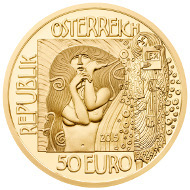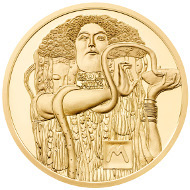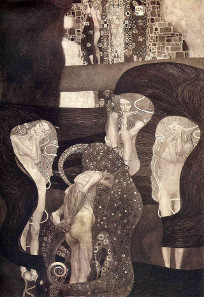April 16, 2015 – The Austrian Mint will issued the fourth gold coin of the commemorative coin series “Klimt and His Women”, featuring the lost paintings entitled “Faculty Paintings.” These paintings were the last public commission by this Viennese master.
Austria / 2015 / 50 euro / 986 gold / 22mm / Design: Thomas Pesendorfer (obverse) and Herbert Waehner (reverse) / Mintage: 30,000.
The obverse of the coin shows a detail from Klimt’s painting “Jurisprudence”, in the form of the Eumenides. Stylised snakes accentuate Klimt’s customary swirling patterns of the gorgon’s hair in the centre, which is highlighted in a square, echoing the frame of the painting. Geometric patterns, which almost seem like floating bubbles, link the two design areas of the obverse. To the right stands Justitia, the frequently used symbol of jurisprudence. Also on the obverse appear the country of issue, “Republik Oesterreich” or Republic of Austria, the face value of 50 euros and the year of issue, 2015. The Mint’s chief engraver, Thomas Pesendorfer, engraved the obverse.
The reverse shows a detail from “Medicine.” The Aesculapian snake winds around the arm of Hygieia, daughter of the Greek god of medicine. In Hygieia’s left hand is the cup of Lethe. The many geometric details that fascinated Klimt are once again noted in the background of this design. The fourth letter, the letter “M” in the word “Klimt”, appears in the lower portion of the reverse. Mint engraver Herbert Waehner engraved the reverse.
Jurisprudence, 1899-1907. Destroyed painting for the University of Vienna. Source: Wikipedia.
Painted between 1900 and 1907 to decorate the ceiling of the assembly hall of the University of Vienna, these works of art were spoken of by all kinds critics of Klimt who believed they broke cultural taboos and pushed the boundaries of obscenity. The critics included the public, the university, art critics, and politicians. Originally he was commissioned to paint the three subjects of Philosophy, Medicine and Jurisprudence in an allegorical style. However, he submitted renderings for approval that were not historically conservative but rather very thought provoking. He was asked to rework his paintings several times, which he refused to do. Instead, with the help of his wealthy patrons, he returned the commission fee (which would be some 500,000 USD today) and the paintings disappeared into private hands. In 1943 the paintings were publically exhibited one last time and then hidden in Immendorf Castle for safety during the war, along with many other Klimt paintings.
Jurisprudence, the painting featured on the obverse, centers on Eumenides, or the Greek deities of vengeance. The male figure included in the original painting was grasped in the multi-armed tangles of an octopus. Critics regarded this painting as a “psycho-sexual” fantasy of Klimt.
Portion of Klimt’s painting Medicine, 1900-1907. Source: Wikipedia.
The painting of “Medicine” includes the complex and ambiguous style noted in this series of Klimt paintings. Hygieia represents cleanliness and health, along with the cup of Lethe representing forgetfulness. The painting originally also had dying men, women and children in the background, while Hygieia stoically stands tall in the foreground. One has to wonder why.
Klimt was no stranger to controversy but this series of paintings caused such an outcry by Austrians at the time, that the politicians even debated these paintings in national parliament. Many viewed the paintings to be too explicit even pornographic. Additional criticisms were launched at the Medicine painting because Klimt had not honored the many global pioneers from Austria in the field of medicine.
Unfortunately not only were the public and politicians outraged, but at the end of the Second World War the retreating forces of the SS burned the paintings.
Each of the coins in this gold collection includes a different painting of a woman representing the five major phases of Klimt’s artistic career. Each coin also depicts a letter in his last name: K, L, I, M, and T. Once complete, the coins of the series will spell the word ‘KLIMT’.
The new coin is struck in 986 fine gold to a maximum mintage of 30,000 pieces in proof quality only. The diameter of the coin is 22mm and it contains 10 grams of fine gold. Each coin is packed in an attractive box with a numbered certificate of authenticity, which is six pages in length and provides detailed background and technical information about the coin.
The last coin of this series in 2016 will feature “The Kiss.”
For more information on this coin visit the website of the Austrian Mint.
More information on the previous issues of this series is available in our archive:
Third gold coin “Judith II”
Second gold coin “The Expectation”
First gold coin “Adele Bloch Bauer”
Until now you can visit Klimt’s studio in Vienna which is managed by the Klimt Memorial Society. You may like to take a look on it here.
Many information on Klimt and his whole oeuvre are available to view in the Klimt Online Museum.








